Polaroid’s Secret Showman
Kalanag and the magic of instantaneity
Jonathan Allen with Jan Isenbart
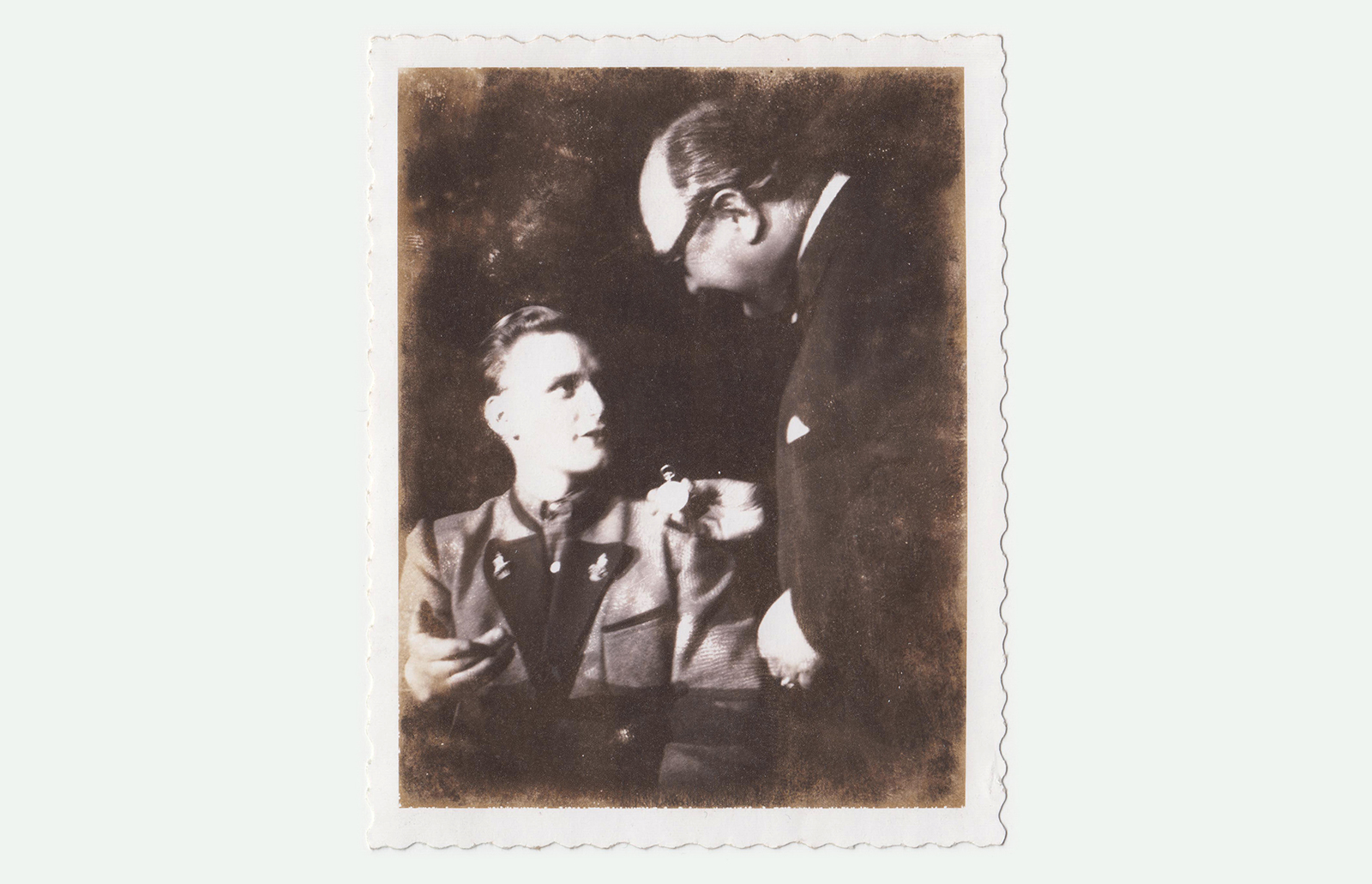
If it has become more urgent now to analyze instant photography’s magic, precisely at the point when its technology advances towards obsolescence, it is because we have not so much left behind the cultural frame of instantaneity opened up by the Polaroid as become absolutely immersed in it.
—Peter Buse, The Camera Does the Rest (2016)
In the spring of 1954, Reinhard Müller stepped onto a stage in the German city of Wolfsburg as a volunteer in a magic show. His presence was captured in a small sepia photograph, where he can be seen in conversation with a tuxedoed magician holding the elegant pocket watch that Müller has just entrusted to him.[1] The conjurer is Helmut Ewald Schreiber (1903–1963), better known by his stage name Kalanag. He is in the final stages of a trick called “The Devil’s Mail,” a popular feature of his world-touring magic revue, Simsalabim. A few moments before, Müller’s watch had been reduced to fragments in a mortar by sharp blows of the magician’s wand. In the photograph, Kalanag can be seen returning the now miraculously restored timepiece to its owner. But his watch is not all that Müller will take with him when he leaves the stage. To his delight, he will also carry this snapshot, delivered to him in an envelope by the magician within moments of the very scene that it depicts.[2]
In an era of smartphones and accelerated digital networks, photographic instantaneity has become a commonplace. In the early years of Kalanag’s show, however, this photograph would have been a sensation, especially since neither a camera nor a photographer had been visible on stage at any point prior to its appearance. Rubber-stamped in green ink on its reverse with the words “Kalanag’s Magical Flashfoto,” Müller’s souvenir even bore a timestamp of sorts handwritten on the envelope: forty-seven minutes past six in the evening, on 11 March 1954.
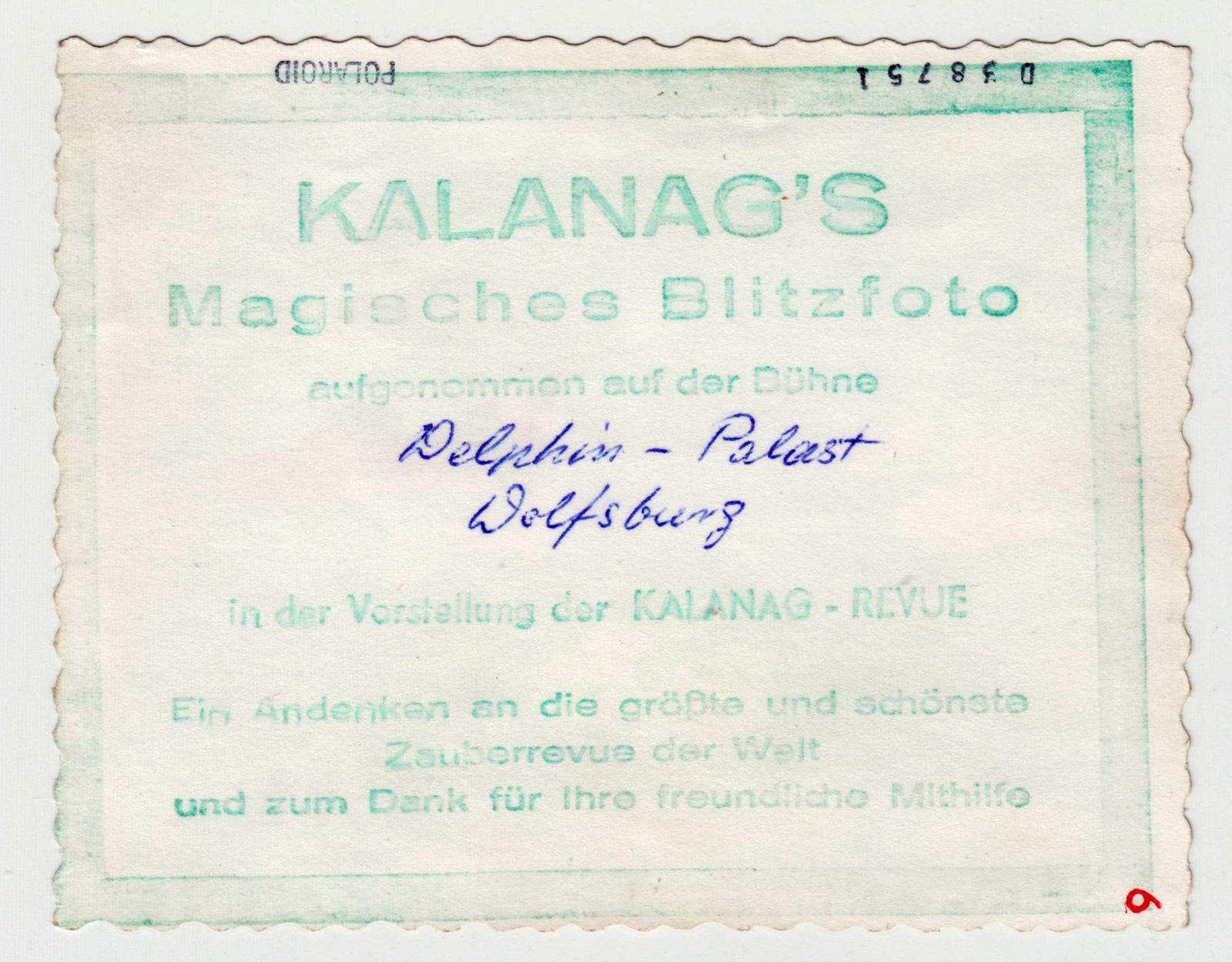
The camera used by Schreiber in Wolfsburg was Polaroid’s first instant camera, the Land Model 95, released for public sale in the United States in late November 1948 by its charismatic creator, Edwin H. Land (1909–1991). Yet this was not the first time that Schreiber had used Land’s groundbreaking device on stage. The trick, described by the magician as “The Fastest Photograph in the World,” features on his playbills during the spring of 1948 and appears to show Schreiber making use of one of the most influential cameras in photographic history many months before its first models became available to the American public.[3] How, in the ruins of post-war occupied Hamburg, did a German magician gain access to this cutting-edge device? Furthermore, was Schreiber—“Hitler’s chamber magician” and performer to Joseph Goebbels, Hermann Göring, and many other prominent Nazis—one of Polaroid photography’s earliest creative interpreters, if not its first?[4]
Helmut Schreiber’s understanding of the darkened performance space of the theater and the photographic darkroom developed simultaneously. An avid conjurer from an early age, Schreiber was the editor of the German magazine Magie between 1927 and 1945, and the president of the German Magic Circle from 1936 to 1945. However, it was his early interest in film production, particularly the stop-motion techniques of French magician and filmmaker Georges Méliès, that shaped his early career.[5] Before the outbreak of World War II, Schreiber held a position at Tobis Filmkunst, where, in 1939, he produced Robert und Bertram, the only anti-Semitic musical of the Nazi era.[6] In 1942, within the newly nationalized German film industry, he was promoted by Reichsminister Goebbels to production chief of Bavaria Filmkunst in Munich, and at the same time appointed to the advisory board of the Reich’s film academy. This positioned Schreiber, then “the virtual czar of conjuring” in Germany, at the very center of the country’s film production in the buildup to, and throughout, the war.[7] Schreiber wrote in 1936 that “the greatest magician—and a magician who succeeds in everything and who can make anything happen—is probably film.”[8] While this curious statement appears to prioritize the moving image above magic as a tool for re-envisioning the world, it also suggests that Schreiber felt that the two mediums might somehow coalesce through his own activities.
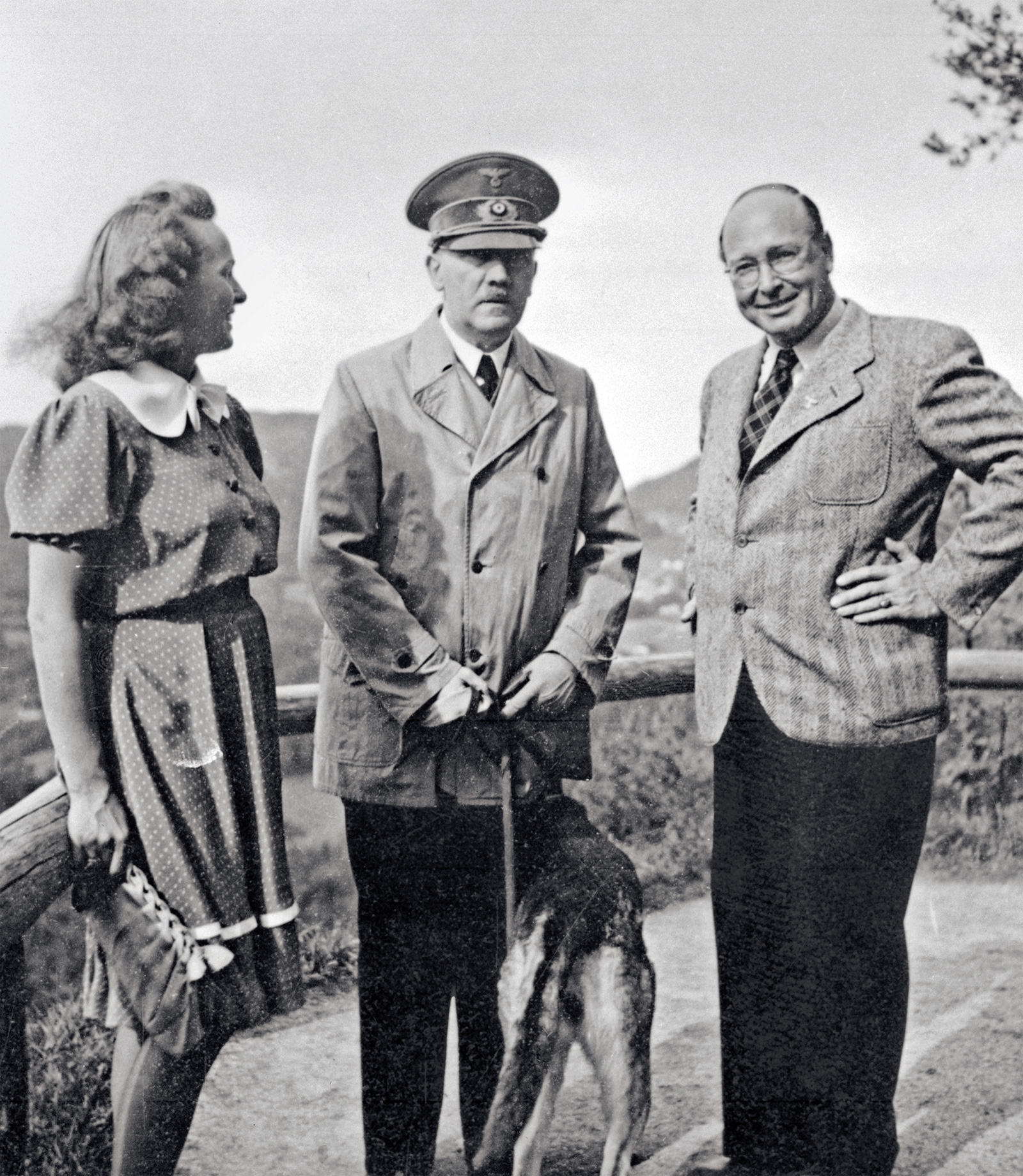
According to Edwin Land’s biographer Victor K. McElheny, the inventor’s early interest in science was encouraged by his fascination with optical toys, in particular during visits to his hometown library where Land later recalled that “the chief delight” had been a Brewster stereoscope.[9] Land’s later pioneering photographic work tends to eclipse his first, and arguably more pervasive, invention: the glare-reducing polarizing technology found on windows, car windshields, and sunglasses worldwide. A 1938 Reader’s Digest article entitled “The Magic of Polaroid” opens with a description of Land’s “strange new product” and its use within the observation car of the Union Pacific’s railway streamliner City of Los Angeles, whose circular “magic windows” could be variably adjusted to control the passage of light.[10] In his 2016 cultural history of Polaroid photography, The Camera Does the Rest, Peter Buse shows how terminology derived from magic, and in particular conjuring, was continually associated with Land and his company’s products. When Life celebrated the arrival in 1972 of a newly compact Polaroid model, the magazine’s coverline linked the inventor’s creative genius directly to his “magic camera.”[11] Commentators elsewhere noted Land’s “photographic legerdemain” and “technological wizardry.” Such was his reputation as an industry showman that one journalist went so far as to describe Polaroid’s yearly corporate gatherings as “Dr. Land’s Annual Magic Show.”[12]
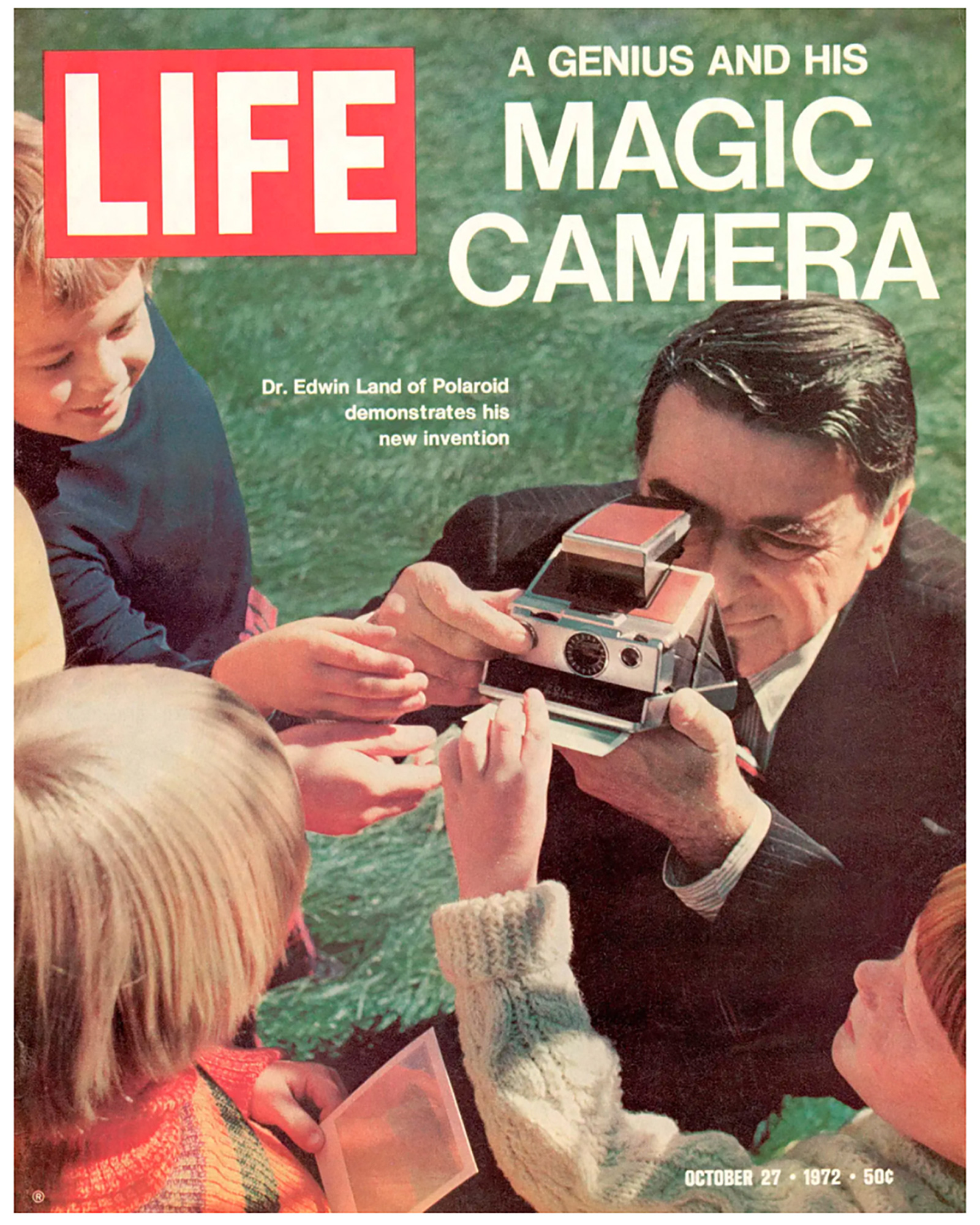
No examples have been found by the authors that show Land himself performing conventional conjuring tricks in a theatrical context, although, given the inventor’s charisma and stage presence, the possibility is not entirely unimaginable.[13] A live magic show was, however, the company’s choice of entertainment on Christmas Eve in 1946, when Land also offered his employees a tantalizing clue about Polaroid’s still top-secret photography project, cryptically referred to as “SX-70.” Land introduced magician Warren E. Simms as “a friend of Houdini, Thurston and Kellar … [who] entertains frequently at the White House. … I suppose that the most appropriate kind of entertainment for Polaroid we would hope is magic, and I think we’re about to see somebody who can out-do us.”[14] At the end of the evening, Land screened a short film clip, announcing beforehand that “if you keep your wits about you, and if you’re good detectives in the way our magician taught us to be, you will see near the end of this movie something that may probably suggest to you what SX-70 is.” The film clip was drawn from Raoul Walsh’s 1945 romantic comedy The Horn Blows at Midnight, in which an angel, played by Jack Benny, is photographed in heaven by other angels who use a futuristic camera to shoot, develop, and deliver his likeness within seconds.
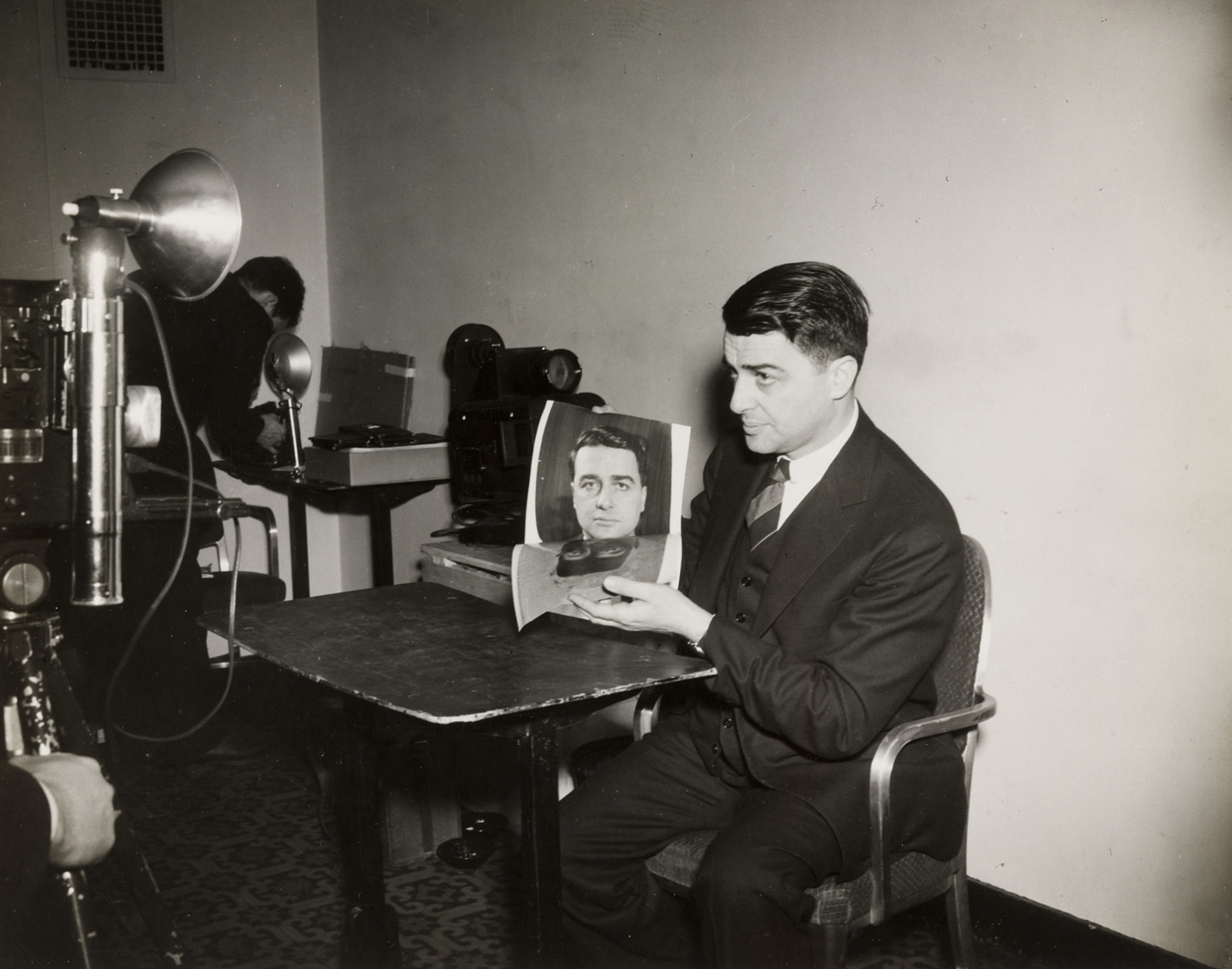
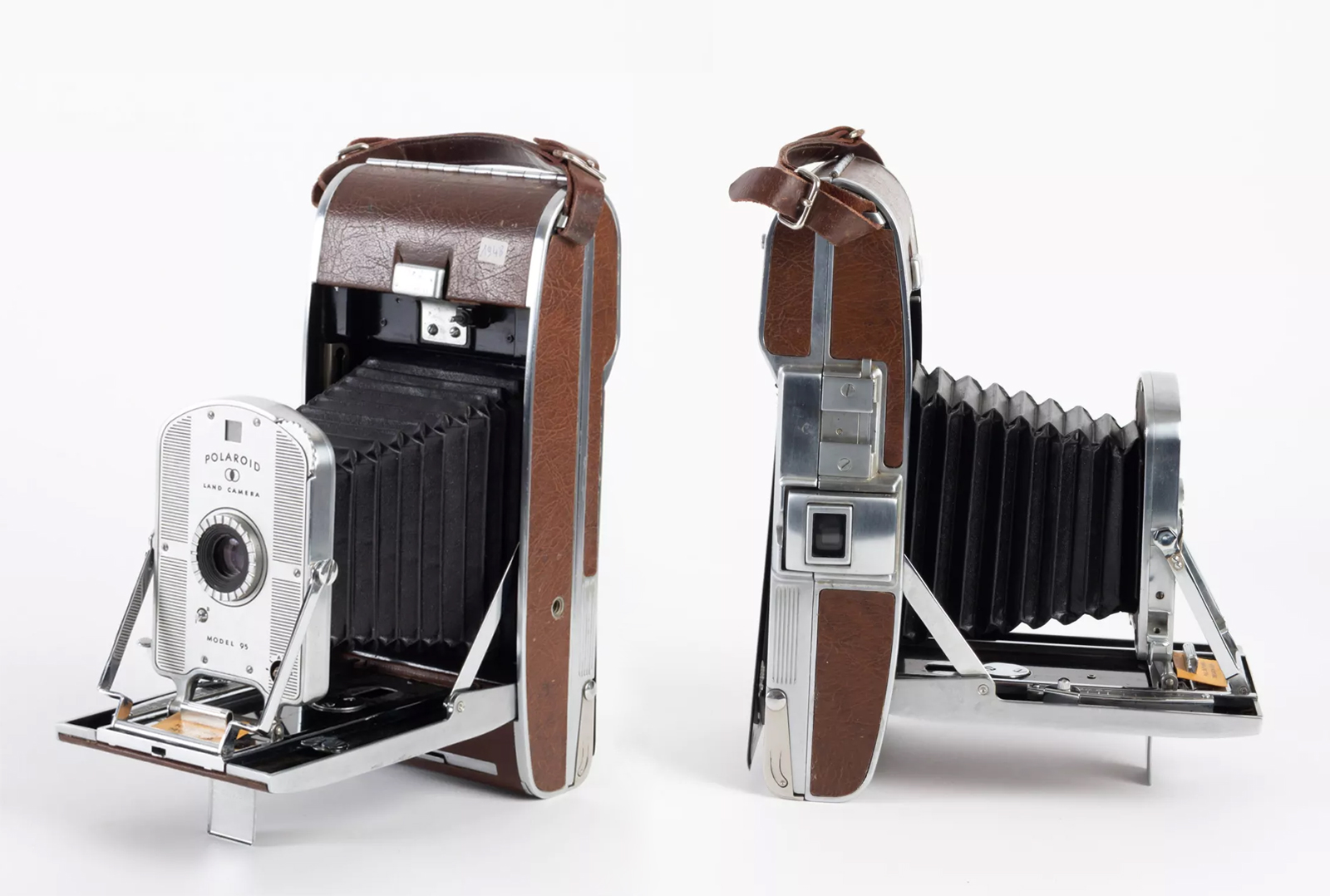
The culmination of the SX-70 project was the Land Model 95 camera, whose launch at Boston’s Jordan Marsh department store on 26 November 1948 was announced with newspapers advertisements bearing the tagline, “… it works like magic!”[15] In early 1949, the company’s marketing language was actualized once again when a fifteen-minute, primetime CBS television show was co-sponsored by Polaroid and the Pioneer Scientific Corporation to promote Polaroid television filters.[16] “The Polaroid Magic Show,” as the series was initially described on a mailer, had begun with controversy when a misleading article appeared in the New York Times just a week before the first broadcast, explaining how Polaroid’s forthcoming magic series, retitled “Now You See It” and hosted by André Baruch, would “reveal to the audience how each trick worked.”[17] The article drew an immediate complaint from Al Altman, the ethics committee chairman of the Society of American Magicians, prompting an apology from CBS.[18] Despite this fractious start, the twice-renamed show, The Masters of Magic, was aired weekly at 7:45 pm from mid-February to mid-May 1949, and featured established international performers such as Milbourne Christopher, Ade Duval, and Richiardi Jr.
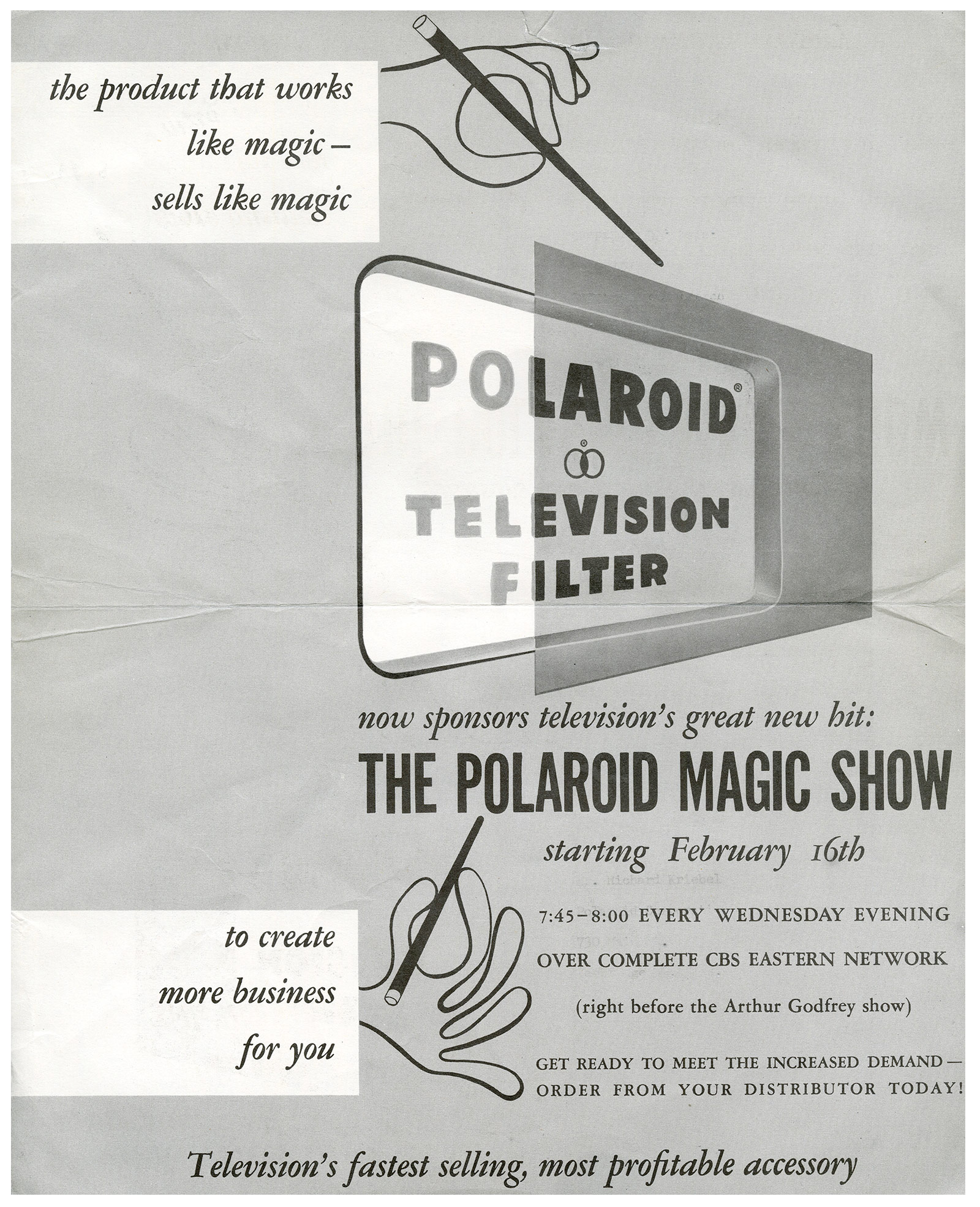
By the time that The Masters of Magic was broadcast, “The Fastest Photograph in the World” appears to have been a feature of Kalanag’s show for at least ten months. What circumstances had led to Schreiber’s pre-emptive access to this groundbreaking photographic device? There are currently no clear answers to that question, but a number of contextualizing factors can be taken into account. First, as a longstanding film-industry insider, Schreiber may well have had advance knowledge of Land’s technical breakthrough.[19] Had the two men not been opposing belligerents during the recent global conflict, one could envisage the ambitious magician-filmmaker soliciting Polaroid for a pre-sale model of the camera on the grounds that its experimental use by him on the theater stage, or on film sets, might yield practical information useful to the company.[20] Without that option available to him, Schreiber may have turned to the black market during the immediate post-war period to gain access to the camera. According to his former stage manager Ludwig Hanemann (1907–1996), otherwise known as the magician Punx, Schreiber was “the king of the black market in Hamburg. He had everything; he had money, he had dollars, he had antiques, … he had diamonds.”[21]
Could a Land camera, then, have come into Schreiber’s possession through entirely illegal means? Unflatteringly, Punx lends credence to this theory, adding that “Germany was full of American gangsters and robbers, and they were the correct partners for Helmut Schreiber.”[22] Whatever contingency led to the camera’s conveyance, Schreiber’s magical and photographic literacy quickly allowed him to repurpose Land’s invention. If rhetorical magic helped Polaroid sell the Land Model 95, then Schreiber found a way to deploy the camera well in advance of its public launch to sell his own brand of enchantment.
How precisely did Kalanag use the Land camera on stage? “The Fastest Photograph in the World” appears to have been added to his show as a “kicker,” that is, an effect that provides added impetus to the ending of an already strong trick.[23] That trick, “The Devil’s Mail,” was usually referred to in the magician’s stage notes simply as “Die Uhr” (The watch). In striking contrast to the contemporaneity of Polaroid’s technology, this conceit reached far back into conjuring’s repertoire. One of the earliest references to the trick appears in Henri Decremps’s 1784 exposé of the Italian conjurer Chevalier Pinetti, La Magie blanche dévoilée, where it is referred to as “La Montre pilée dans un mortier,” a title translated in 1785 by Thomas Denton as “The Watch Beat to Pieces in a Mortar.”[24]
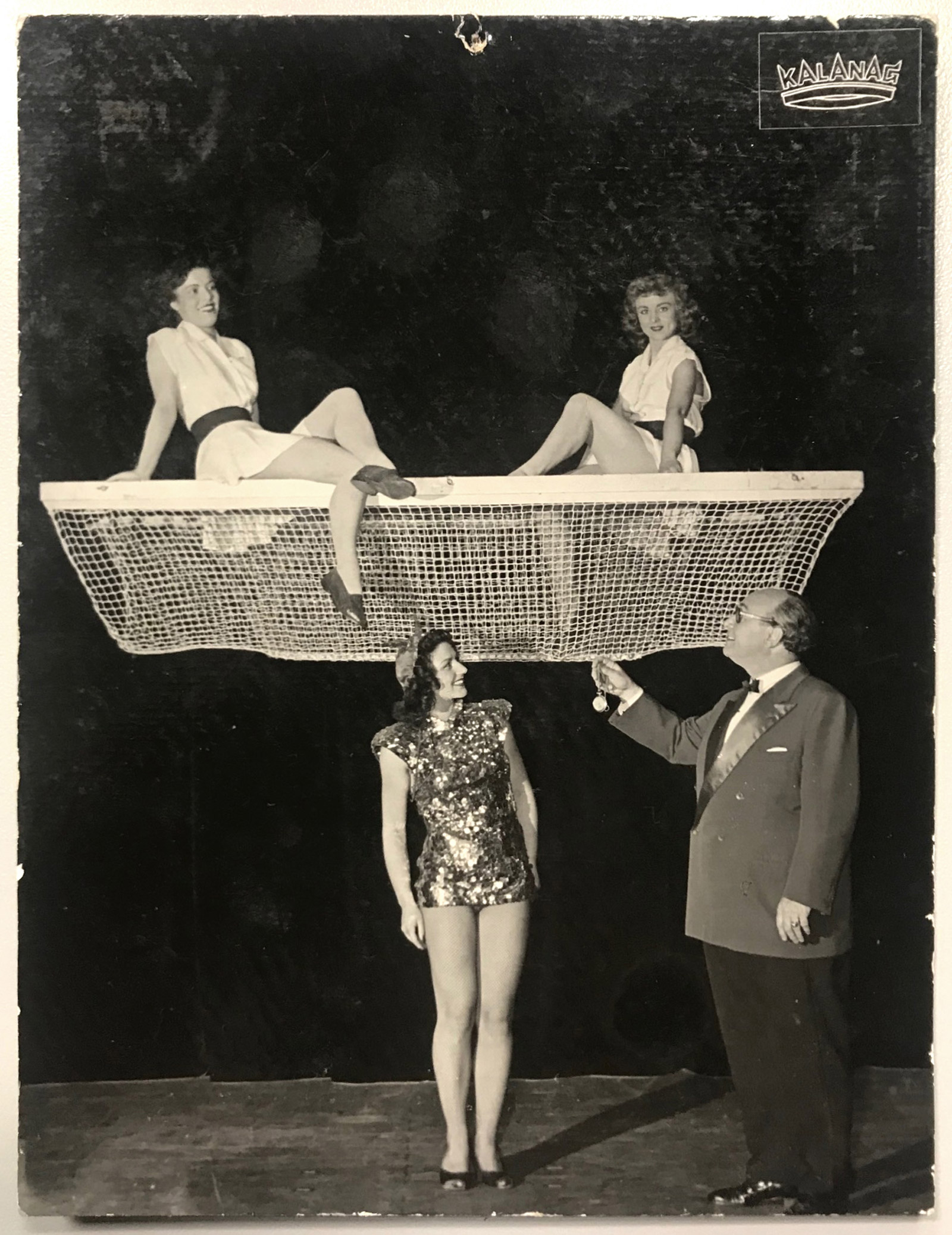
In Kalanag’s updated and considerably more complex version, a volunteer willing to loan their watch was welcomed to the stage and seated on a small stool. With theatricalized carelessness, their watch was broken into pieces by the magician and its fragments folded into a cone of paper. This package was then passed to a stage assistant who stepped into a large outstretched net lying on the stage.[25] Now raised aloft, the net suddenly dropped, instantly vanishing the assistant and leaving the sheet of paper fluttering to the ground. Seconds later, the same assistant reappeared high above the stage, now crouched in a suspended glass box and carrying a wrapped parcel tied tightly with string. When lowered to the ground, the assistant delivered the eponymous “devil’s mail,” which, when unwrapped, contained a series of nested wooden boxes within which the undamaged timepiece was eventually found. As if this bewildering sequence was not complex enough, it was at this point that Kalanag reached into his jacket pocket and drew out a sealed envelope addressed in person to his volunteer. The photograph inside depicted the two in conversation, with Kalanag holding the intact watch between his fingers.[26] An epidiascope—a type of enlarging projector—was then sometimes used to project the tiny image onto a large screen in order for the audience to confirm the identity of its sitter and to share in the photograph’s apparent impossibility.[27]
One of the many challenges that Kalanag faced in the design of this trick was to find a means through which to covertly position and operate Land’s camera, an object some twenty-six centimeters in height and weighing almost two kilograms. His first solution, it seems, was to direct the camera toward the stage from a concealed location in the theater wings, although this also required the use of a flash exposure to produce a Polaroid of sufficient clarity. As late as 1954, Kalanag was still sometimes hiding the camera in this way, as can be deduced anecdotally from Reinhard Müller, who remembers a “flash from the wings” while on stage.[28] The account of another volunteer reveals Schreiber’s alternative strategy. When Bruno “Joro” Hennig sat down on the stage of the Kaiserhof in Cologne in February 1956, he was approached by a stage assistant with a vendor’s tray who offered him a refreshment. Only later did he realize that the photograph he subsequently received had been shot using the “newly born Polaroid camera … hidden inside of the vendor’s tray!” [29]
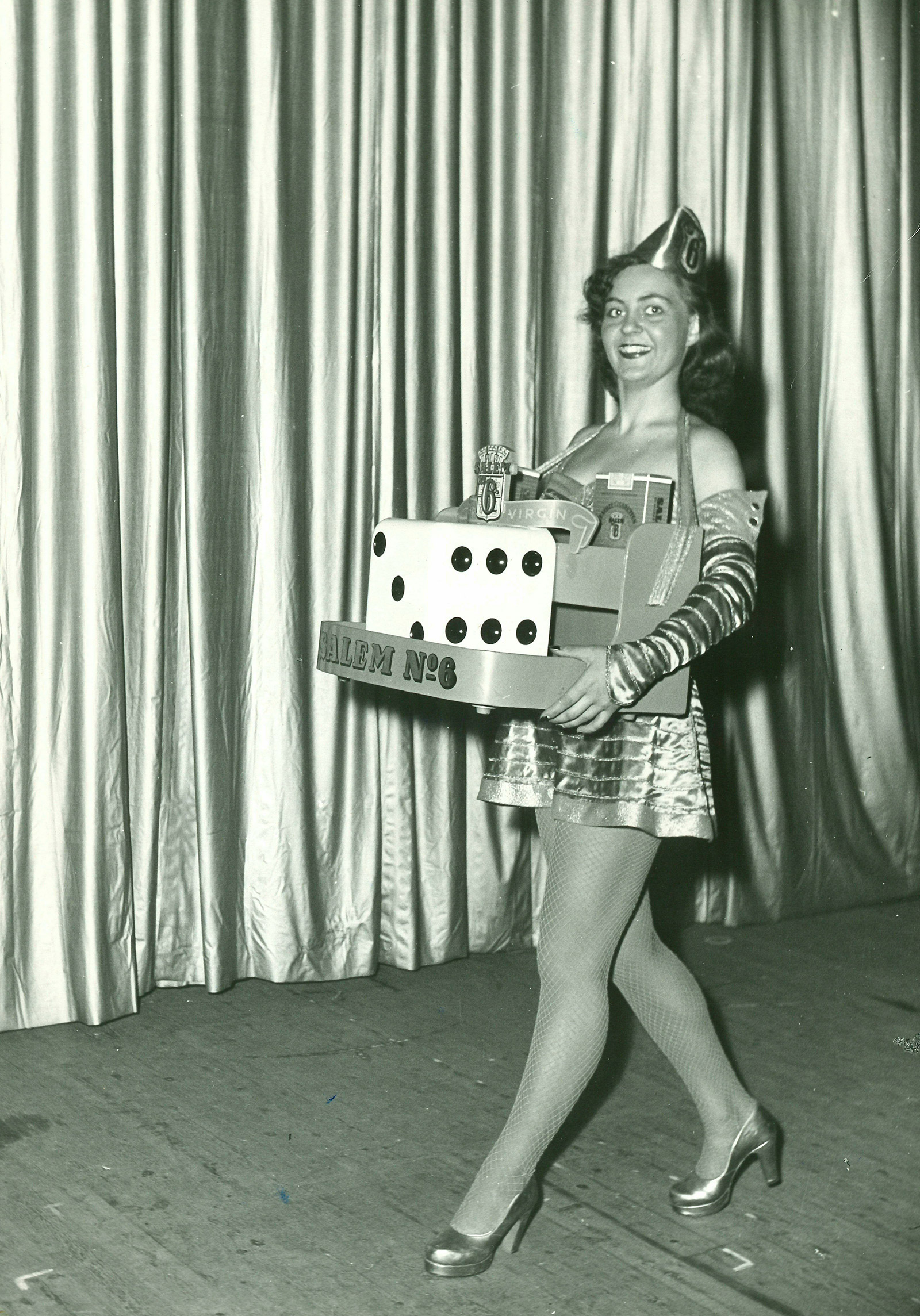
The bespoke tray described by Hennig passed to other magicians and collectors following Kalanag’s death in 1963.[30] One prominent element of the tray’s customized design allowed for the camera’s concealment: a large white die whose front face displayed the number three and through whose central spot the lens of the hidden camera could be directed. On the pretense of offering the seated volunteer an item from the tray, one of the magician’s co-performers was able to take up position at a pre-planned distance in readiness for the exposure.[31] As shown by surviving performance scripts, Kalanag then fixed the volunteer’s attention—and thus head position—using a barrage of non sequiturs: “The watch belongs to you? … Cigarette? … How long have you had the watch? ... Are you married?” When a number of these souvenir photographs are placed alongside one another, their compositional similarity reveals just how effective this form of interrogation proved to be.
One might think that an unusually large white die atop a vendor’s tray would have aroused the suspicions of audiences at Kalanag’s performances. The fact that it did not was due to another aspect of the magician’s professional acumen: his commercial instincts for product placement and sponsorship opportunities. In fact, German audiences in the mid-1950s would have been quite familiar with this particular motif since it was central to the celebrated posters of that period designed by Swiss artist Herbert Leupin for Salem No. 6, a cigarette brand made by the German company Reemtsma. In these advertisements, a single white die—always with its lucky-six facing outward—appeared alongside matchsticks, cigarettes, and playing cards, all set within poised realist compositions that evoked the risk-taking glamour of the casino and projected it onto the smoking habits of the German public during an era of uninhibited tobacco marketing.
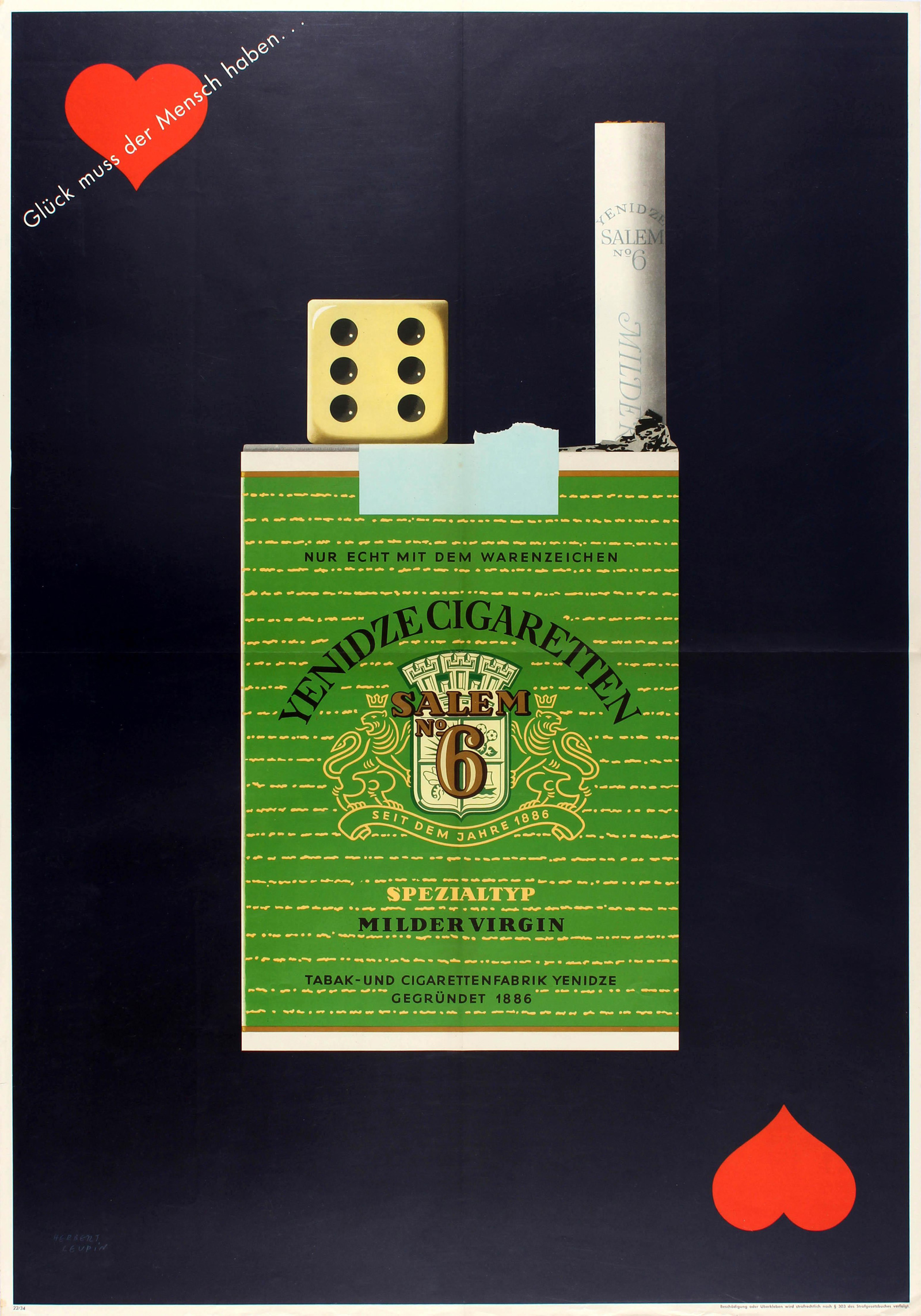
Between 1952 and 1956, during the height of Leupin’s campaign, Schreiber’s German programs record Reemtsma as a sponsor. Although the contractual details of this business arrangement remain obscure, photographs from the company’s archive indicate that Schreiber’s inventive solution to this hybrid problem—one both magical and semiotic—surely played a part in securing the deal. The photographs show a young woman, almost certainly one of Kalanag’s co-performers, and perhaps even one of the photographers for “The Fastest Photograph in the World,” posing in front of a stage curtain carrying the die-bearing tray on which several Salem No. 6 logos can be clearly seen. Although Schreiber continued to position the camera in the theater wings when circumstance required, it is clear that, from around 1952, the vendor’s tray became the principal means through which he and his co-performers concealed and deployed Land’s camera.
Throughout 1948, and perhaps for a year or so thereafter, Kalanag would have been considerably ahead of his audiences, whose knowledge of Polaroid’s new technology would at the time have been very limited.[32] Within a few years, however, those same audiences would have been far more attuned to Land’s invention. Despite the trick’s diminishing capacity to surprise, “The Fastest Photograph in the World” remained a regular feature of Schreiber’s show for a decade and a half, during which time countless volunteers left his shows in possession of a photograph rubber-stamped in green ink on its reverse with the words “Kalanag’s Magical Flashfoto / taken on stage / during a performance of the Kalanag Revue / A souvenir from the biggest and most beautiful / magic revue in the world / and as a thank you for your kind assistance.”[33]
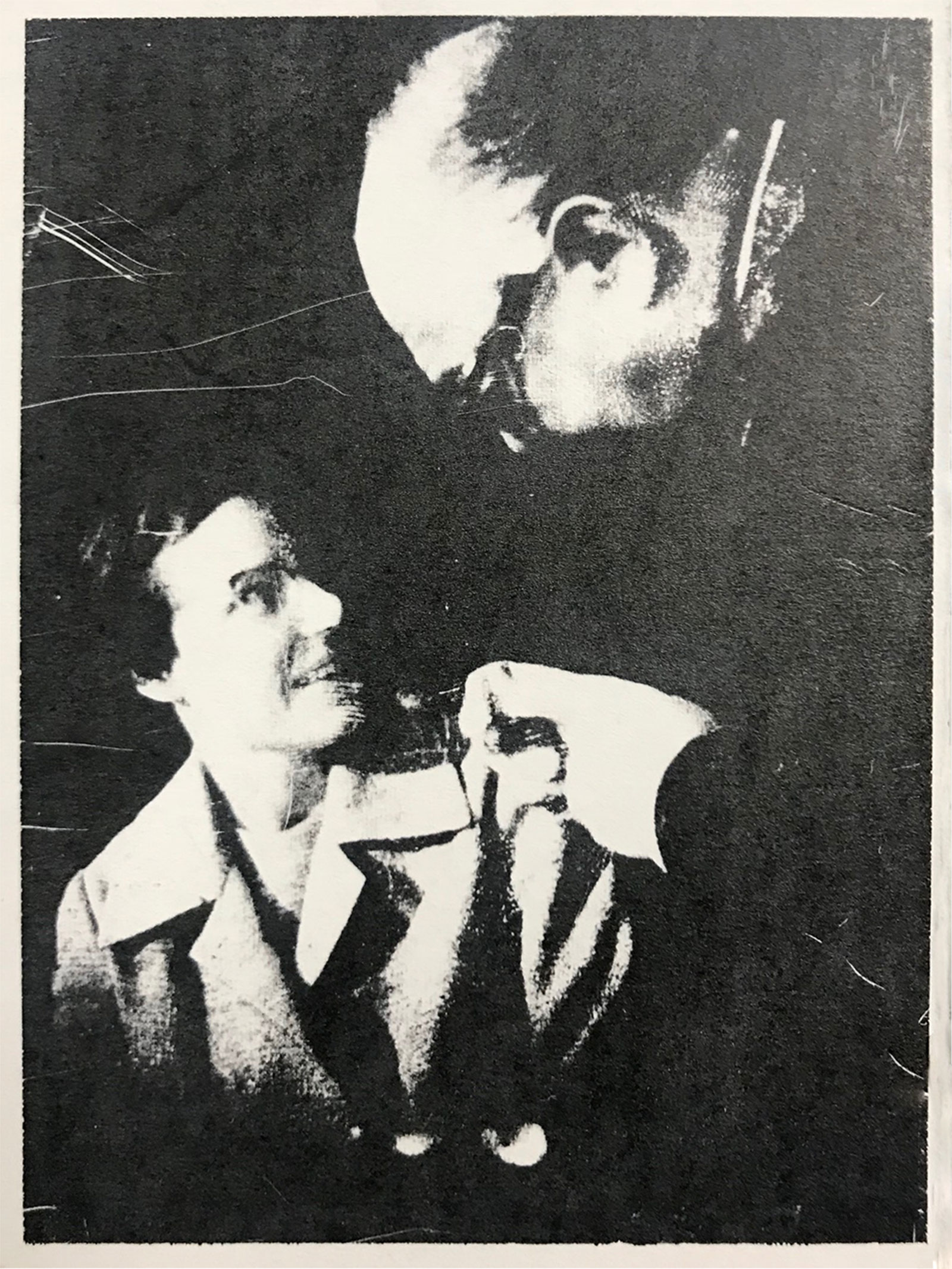

As media historians Frédéric Tabet and Pierre Taillefer have recently shown, late nineteenth-century magicians had quickly recognized photography’s potential as a promotional tool and had, in various ways, conveyed photographic images to their audiences directly from the stage.[34] What distinguished these earlier examples of stage-bound photo-publicity from Kalanag’s Polaroids was that the latter allowed the magician to gift his volunteer an image of their interaction almost in real time. The capturing of these photographs might, in any other context, have been considered problematically non-consensual.[35] On a magic show stage, however, where capitulation to various forms of theatricalized deception is concomitant with entertainment, the resulting images, once projected using the epidiascope, temporarily bound together the volunteer, the audience, and the magician, before the Polaroid itself was returned to its subject in the form of a unique—that is, unreproducible—souvenir.
Read another way, these images can be seen as working portraits of a male magician shot by his (mostly female) co-performers.[36] In one photograph taken near the end of his life, Schreiber appears to be emerging from, or perhaps withdrawing into, the stage shadows. The aloof disposition of his volunteer is matched only by the magician’s apparent self-absorption. By then, Edwin Land’s invention was a worldwide commercial success, while Schreiber’s now-outmoded trick would have lost much of its appeal.[37] Furthermore, live magic itself was being supplanted by a new medium—television—meaning that, alongside other mortifications, Schreiber was playing smaller venues. Neither was the magician’s personal legacy assured. His professional reputation had been tarnished, particularly outside Germany, by the revelations of his close association with the Third Reich and his suspected membership in the Nazi Party.[38] His wife and leading co-performer, Gloria de Vos, had left him. Like an iconographic personification of time, Schreiber points at his volunteer’s watch. He will be dead within ten months.
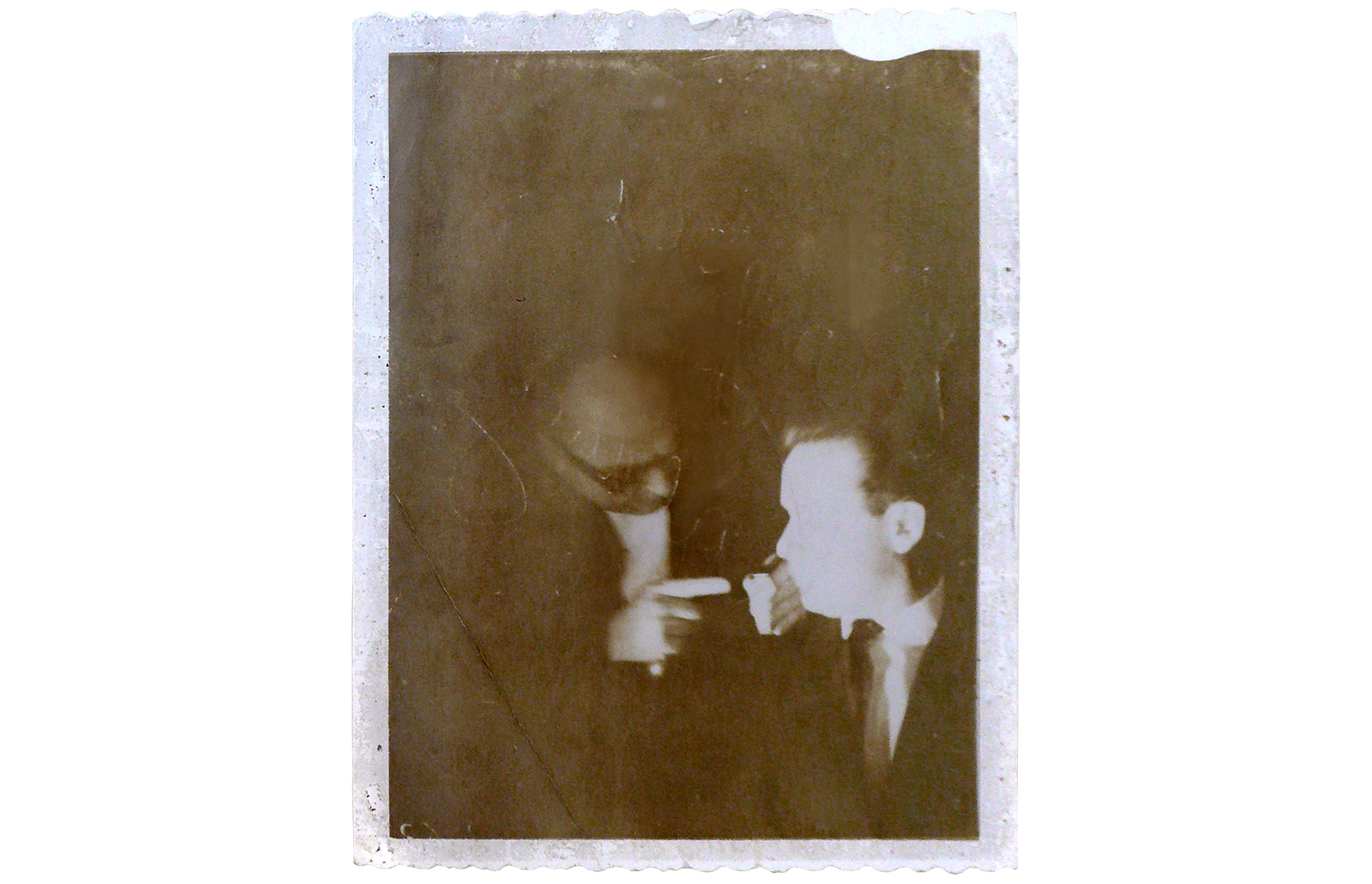
The legacy of Kalanag’s photographic mystery can be understood in a number of ways. In strictly conjuring terms, “The Fastest Photograph in the World” constitutes an elaborate variation of Decremps’s “The Watch Beat to Pieces in a Mortar,” reanimated in the middle of the twentieth century using an unprecedented imaging technology. The trick also marks the first of many subsequent illusions made possible with variants of Land’s technology, a strand of magical innovation that continues to this day. Moreover, Schreiber’s near-live mediation of a volunteer during his shows anticipates an important contribution to magic made in recent decades by the American magician David Blaine, whose television specials in the late 1990s focused less on him as a performer, and more on his street audiences as they responded to his tricks. Even the cropped-in, over-the-shoulder framing of Kalanag’s Polaroids is reminiscent of footage from Blaine’s TV shows.[39]
Recognizing Kalanag’s work within the history of photography, however, yields a more problematic legacy. In his aforementioned study of Polaroid culture, Peter Buse develops the concept of a “photography of attractions,” which he adapts from the work of film scholars Tom Gunning and André Gaudreault, whose “cinema of attractions” demonstrated that today’s narrative cinema was preceded by film’s earlier success as a popular and sensation-driven spectacle on public fairgrounds, vaudeville stages, and, indeed, as part of magic shows. Buse advances his own theory by recognizing a continuum between the stereography craze of the nineteenth century, seaside while-you-wait cameras, the automated amusement park photo booth, and the participatory pleasures of Polaroid’s instant photography. Alighting from this “photography of attractions,” Buse sketches Land as a “photographic showman,” as well as offering several other compelling examples of the same, including the maverick Chicago bellhop Ted Serios, who came to public attention in the late 1960s when his claimed ability to project mental images directly onto Polaroid film was documented by eminent psychiatrist Jule Eisenbud in his 1967 book The World of Ted Serios: “Thoughtographic” Studies of an Extraordinary Mind.[40] Between 1948 and 1963, Schreiber covertly recast the Land Model 95 as a magical attraction in a way surely unimagined by the camera’s inventor, or by its copywriters. Should Schreiber now not be recognized as one of the technology’s earliest creative interpreters, as Polaroid’s secret showman? “The Fastest Photograph in the World” undoubtedly connects, or perhaps reconnects, a complex and challenging figure to Polaroid’s historical timeline.
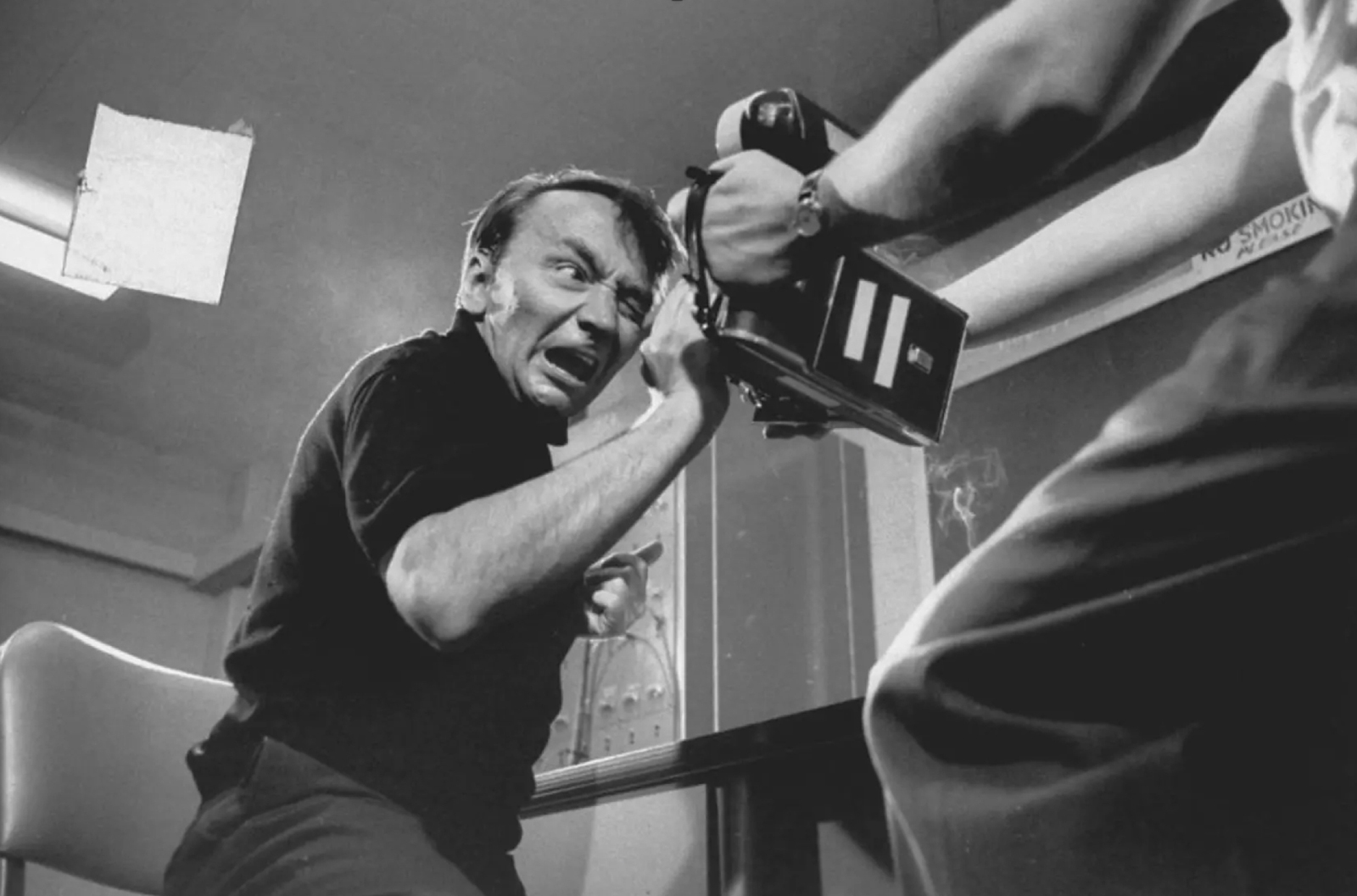
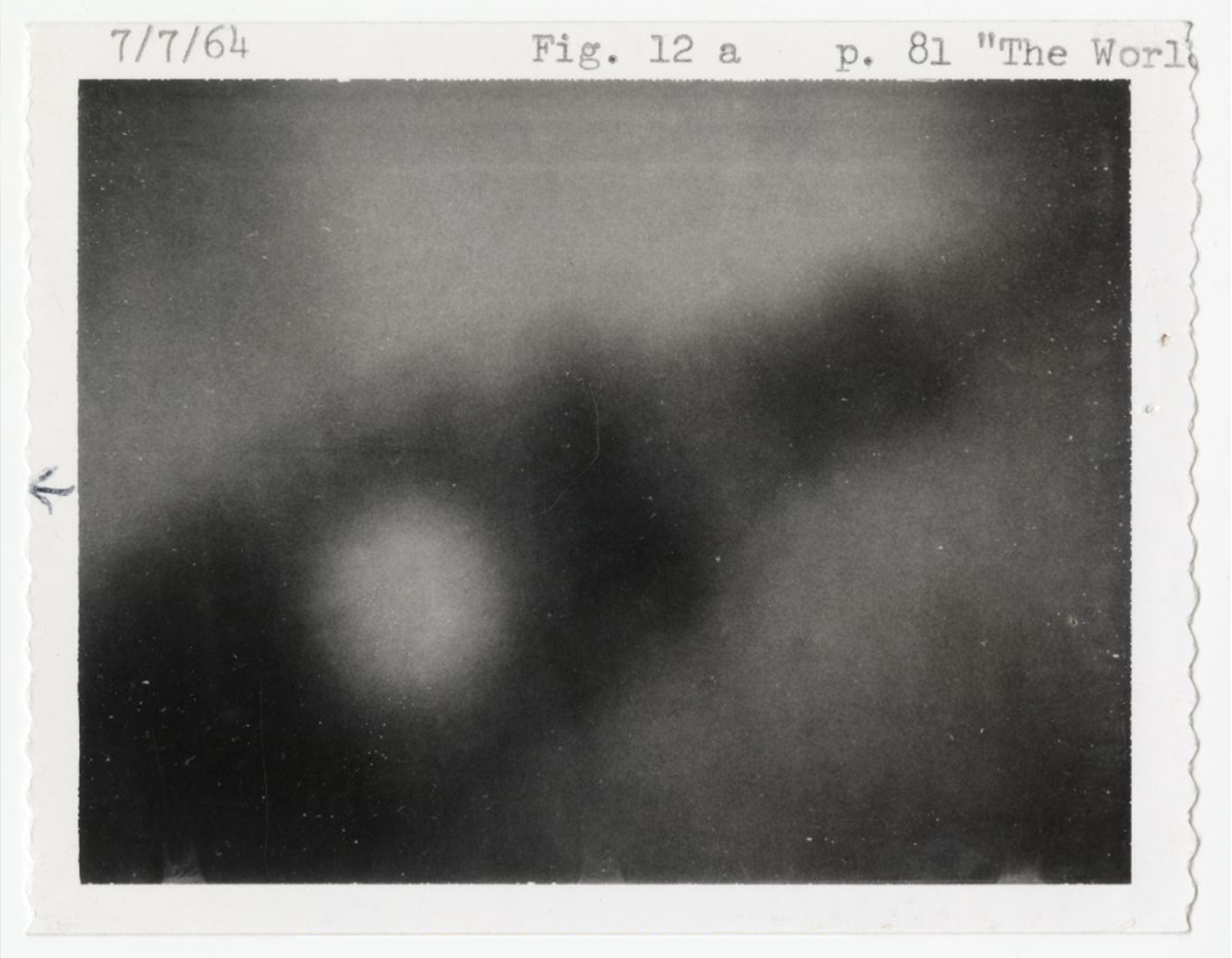
An important question remains unanswered. Was Edwin Land aware of Helmut Schreiber’s covert deployment of his invention? To pose this question seems appropriate enough in the light of Schreiber’s pre-emptive access to the technology, of Polaroid’s widespread use of magic-related promotional language, and of the company’s enlistment of a troupe of globe-trotting conjurers around the same time that Schreiber was experimenting with Land’s invention. It seems improbable that the corporation’s vigilant public relations apparatus would not have been aware of Schreiber’s activity—if not immediately, then soon after the magician first performed using Land’s camera—but, to date, no related documentation has been identified by the authors within the company archive. Perhaps following the turn of events in 1949 with The Masters of Magic, the company’s strategists recognized that conjuring’s representative community could, and would, advocate strongly on behalf of its membership and, as a result, assented to magic’s well-documented codes of secrecy.[41] Alternatively, as Schreiber’s nefarious past began to catch up with him, particularly during his ill-fated US tour of 1957, when enduring anti-German sentiment translated into negative leafleting campaigns, the company and its (Jewish) co-founder might have quietly distanced themselves from any association with a performer linked so toxically to histories still so close at hand.[42]
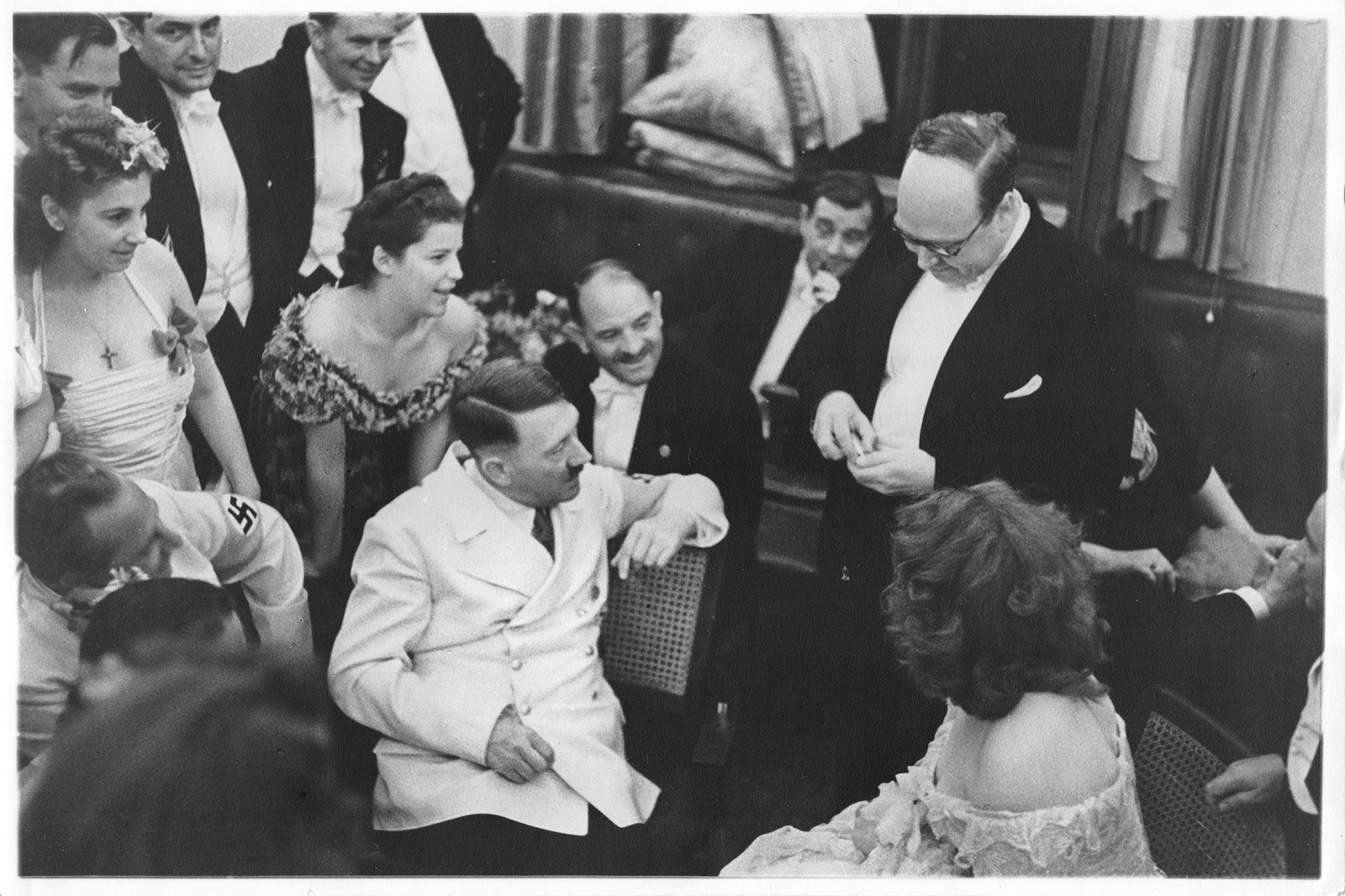
One particular story would certainly have given Polaroid’s executives pause for thought. In Der große Kalanag (2021), Schreiber’s biographer Malte Herwig recounts the revelations of Hitler’s valet Heinz Linge and his adjutant Otto Günsche, who reported to the Soviet secret service NKVD during their interrogation in Moscow after the war, and whose descriptions of the magician’s performances before the Führer reveal just how comfortable Schreiber felt within the Third Reich’s inner circles.[43] Two candid photographs depict one such scene at the Führerbau in Munich in 1939, where Hitler can be seen anticipating and then responding to a close-up trick performed by Schreiber.[44] In their testimony, Linge and Günsche describe another magic show at Hitler’s mountaintop Obersalzberg home in 1944, during which Schreiber presented an audacious version of the trick that was soon to become “The Devil’s Mail.” The effect would be given new impetus by Polaroid’s technology just four years later. The volunteer was Eva Braun, and the watch was a diamond-studded platinum wristwatch, gifted to her by Hitler in 1939 for her twenty-seventh birthday. Had a photographer recorded that moment, the Führer would surely have kept the image as a treasured souvenir.
Jonathan Allen and Jan Isenbart wish to thank the guardians of the Polaroid Corporation records in the Baker Library at Harvard Business School (with particular thanks to Melissa Murphy); Stiftung Zauberkunst, Nottuln; Stiftung Historische Museen, Hamburg; and the many individual photography and magic historians without whose generosity this text would not have been possible. Allen and Isenbart’s shared research was first presented at the Magic Circle History Day in London on 10 September 2022.
- Not yet twenty, Reinhard Müller was already a keen magician and knew about Kalanag’s watch trick. In the hope of being chosen for the act, he borrowed his grandfather’s valuable antique gold watch for the occasion and hurried to the stage once Schreiber called for a volunteer. The authors are grateful to Müller—now a well-known card magician and prolific writer on magic—for his generosity as they prepared this article.
- To most volunteers taking part in this section of Kalanag’s show, and to his audiences, the photograph would have appeared to depict the temporal sequence described by the authors in this introduction. Yet, all was not as it seemed. By standing in an identical position alongside the seated volunteer at the start and the end of the trick, Kalanag deliberately exploited the volunteer and audience’s confusion over precisely which moment in the performance the Polaroid depicted. If the viewer believed that the photograph depicted the end of the trick, then the instantaneity of its appearance would seem all the more remarkable. In fact, the image always depicted the magician and his volunteer at the start of the routine, thereby allowing time for the photograph to be processed backstage and placed in an envelope before being secretly returned to Kalanag onstage. “Time misdirection”—that is, the deliberate manipulation of subjective time perception—is a principle well understood by magicians. See Thomas Fraps, “Time and Magic—Manipulating Subjective Temporality,” in Subjective Time: The Philosophy, Psychology, and Neuroscience of Temporality, ed. Valtteri Arstila and Dan Lloyd (Cambridge, MA: The MIT Press, 2014).
- Helmut Schreiber’s show programs from his first run of performances at the British Army’s Garrison Theatre in Hamburg can be found in the magician’s personal, chronologically assembled scrapbooks, held in Germany at Stiftung Zauberkunst in Nottuln. Although these programs are undated, other documentation within surviving performance files show Kalanag’s performances at the Garrison running intermittently from 19 October 1947 to 20 April 1948. Several of Kalanag’s later Garrison Theatre programs during this period feature “The Fastest Photograph in the World,” indicating that Schreiber must have had access to Land’s camera at some point before the end of that period. An additional run took place at the British Army–operated Garrison Theatre in Iserlohn between 15 and 20 March 1949.
- The term Kammerzauberer, which translates as “chamber magician,” was used by actor Fritz Benscher to describe Schreiber’s untroubled relationship with the Third Reich’s leadership. See Rolf Aurich, Kalanag: Die kontrollierten Illusionen des Helmut Schreiber (Berlin: Verbrecher Verlag, 2016), p. 141. The book’s title translates as “Kalanag: The controlled illusions of Helmut Schreiber.”
- Malte Herwig, Der große Kalanag: Wie Hitlers Zauberer die Vergangenheit verschwinden ließ und die Welt eroberte (Munich: Penguin Verlag, 2021), p. 47. The book’s title translates as “The great Kalanag: How Hitler’s magician made the past disappear and conquered the world.” In contrast to its generally positive obituary issue dedicated to Kalanag in 1964, the American conjurers’ magazine Genii turned its June 2021 issue over to Herwig’s revelatory treatment of the magician, translating a number of sections from the book for English readers. See Genii, vol. 26, no. 6 (January 1964), and Genii, vol. 84, no. 6 (June 2021).
- See Rolf Aurich, Kalanag, pp. 92–98.
- Milbourne Christopher, The Illustrated History of Magic (New York: Thomas Y. Crowell Company, 1973), pp. 401–404.
- See “Film und Magie im Dienste des W. H. W.,” Magie, vol. 19, no. 2 (February 1936), p. 33. German original translated by Jan Isenbart.
- Victor K. McElheny, Insisting on the Impossible: The Life of Edwin Land (Cambridge, MA: Perseus Books, 1998), p. 19.
- See “The Magic of Polaroid,” Reader’s Digest, vol. 33, no. 197 (September 1938), p. 104.
- See Life, vol. 73, no. 17 (27 October 1972).
- See Peter Buse, The Camera Does the Rest: How Polaroid Changed Photography (Chicago: The University of Chicago Press, 2016), p. 127. The first two examples are drawn by Buse from Jack Murphy in “More Magic from the Miracle Worker,” Du Pont Magazine, vol. 68, no. 2 (March–April 1974). The third example is drawn by Buse from Richard Kostelanetz, “A Wide-Angled and Close-up Portrait of Edwin Land and His Polaroid Cameras,” Lithopinion, issue 33 (vol. 9, no. 1; Spring 1974). Such descriptions bring to mind another corporate performer, and a great admirer of Land, Steve Jobs, whose predilection for linking Apple’s products to magical language is a matter of record. Polaroid technology’s link to magical language has continued through the work of Florian Kaps, the Austrian entrepreneur and former spider scientist who salvaged Polaroid’s unique analogue technology for a new generation of image-makers through the Impossible Project. See Kaps, Polaroid: The Magic Material (London: Francis Lincoln, 2016).
- Magicians themselves quickly recognized Polaroid as a potentially useful new material in their theatrical arsenal. In the conjurers’ trade magazine The Sphinx, Kennett H. Malan described how images “as if painted by some ethereal hand” could be produced by selectively swiveling sheets of Polaroid material against one another. See “For Magical Purposes: Two Materials Which May Be Used in a Variety of Effects,” The Sphinx, vol. 39, no. 8 (10 October 1940), p. 188.
- A typescript of Land’s speech can be found in the Polaroid Corporation records, Series V: Records Related to Edwin H. Land, box V.2, folder 10, Baker Library, Harvard Business School. See p. 9 and p. 34. The transcript omits a number of details relating to Simms that can be heard on surviving sound recordings of the event. See Polaroid Corporation records, Series VI: Audiovisual Collection, 014681354_AT_0068, Baker Library, Harvard Business School.
- The relevant section of the ad read: “Gives permanent, brilliant, pictures of excellent quality, the minute they mean the most … it works like magic! snap it … pull tab … enjoy pictures in one minute.” The first batch of fifty-six cameras and the demonstration model sold out within a few hours. For more on the launch event, see Christopher Bonanos, Instant: The Story of Polaroid (New York: Princeton Architectural Press, 2012), pp. 42–44.
- Pioneer Scientific Corporation held an exclusive licensing deal with Polaroid for the popular Polaroid television filter, which greatly increased the viewing resolution of the era’s early television screens. See “Polaroid Paradise: Part Two of a Study of TV Accessories on the Air,” Sponsor, vol. 3, no. 14 (6 June 1949), p. 62. Pioneer’s public relations team—headed up by Bill Cayton of Cayton Inc.—created an independent, hard-selling advertising campaign of which Masters of Magic was just one part. Given Polaroid’s codependent brand association with the product, it can be assumed that the campaign was evaluated and agreed upon by Polaroid’s own marketing team. See also “How a Small TV Accessory Proved a Sales Bonanza for Dealers,” Radio and Appliance Journal, vol. 66, no. 1 (January 1949), pp. 20–21.
- See “Radio and Television: ’Now You See It,’ Show Featuring Magicians, Will Make Bow Feb. 16 on WCBS,” The New York Times, 9 February 1949. A flyer referencing The Polaroid Magic Show and two variations of a booklet titled Parlor Tricks (given free to customers of Polaroid television filters) can be found in Polaroid Corporation records, Series IX: Corporate Archives Records, box IX.25, folder 13, Baker Library, Harvard Business School.
- The apology letter, signed with “Kindest personal regards” by “John J. H. Peyser, Director of CBS’ Masters of Magic,” was published in several magic industry journals, including The Sphinx and M-U-M.
- See, for example, “Polaroid President Invents New Camera That Produces Finished Prints in One Minute,” Camera, vol. 69, no. 4 (April 1947), and Ralph Samuels, “A New One-Minute Process,” Minicam Photography, vol. 10, no. 8 (May 1947).
- Polaroid had long engaged specialist consultants, the most celebrated example being Ansel Adams, with whom Land interacted from 1948 onwards. See Victor K. McElheny, Insisting on the Impossible, pp. 204–205; Peter Buse, The Camera Does the Rest, p. 143; and Christopher Bonanos, Instant, pp. 44–45.
- Hanemann’s comments are drawn from English-language audiocassette recordings he made in Munich on 12 December 1986 and 20 February 1987 in response to written questions from British magician Val Andrews. This citation is from the December recording. The recordings were kindly made available to the authors by magic historian Paul Kieve.
- Hanemann recording of 20 February 1987; by “correct,” he means “appropriate” or “natural.” See also Richard Hatch, “Kalanag and the Vanishing Banknotes,” Magic, vol. 7, no. 11 (July 1998), in which the author investigates Kalanag’s long-rumored association with a large cache of untraced paper currency and gold bullion previously “part of the Reichsbank reserves carefully hidden at the end of the war in the hopes of someday financing a Fourth Reich.” See also Malte Herwig, Der große Kalanag, pp. 246–252.
- In some of Kalanag’s programs dating from October 1947, “The Devil’s Mail,” or “Mail from Hell—A Devilish Affair,” features without reference to the later-added photography trick. Programs for Schreiber’s performances at the Garrison Theatre in Hamburg throughout 1948 feature the trick, which is commonly referred to as a separate show item, but linked by an ellipsis: “The Devil’s Mail … and the fastest photograph in the world.”
- Thomas Denton, The Conjurer Unmasked; or, La Magie Blanche Dèvoilèe … Translated from the French of Monsieur Decremps (London: privately printed, 1785).
- “The Devil’s Mail” comprised a number of independent effects, each with their own performance histories and authorship, linked together as a performative assemblage that varied over the years and from venue to venue depending on the theatrical resources available. For instance, the vanishing illusion involving the net—also known as “Dizzy Limit” or the “Bengal Net”—was originated by Oswald Williams around 1924.
- The precise staging of the “The Devil’s Mail” is described by East German magician Wolfgang Scheuer in his detailed article “Kalanag’s Uhrenmörser,” in Mauerspechte, ed. Alfred Czernewitz (Rheinbach: printed by the editor, 1991). Following Schreiber’s death in 1963, Scheuer presented part of Kalanag’s show for several weeks in November–December 1965 at the famous Friedrichstadt-Palast in East Berlin.
- A prop list probably related to the magician’s 1954–1955 tour of England includes “Quick photo with epidiascope,” and there are references to a projection screen elsewhere within surviving stage notes and performance records. This added layer of mediation may have been introduced to Kalanag’s show in response to feedback from audience members or in response to show reviews. See, for example, Arnold Furst, “Kalanag—Review of His Show at Franz-Alt[h]off-Bau Theatre, Frankf[u]rt, Germany,” Genii, vol. 20, no. 7 (March 1956). Spelling errors in the title have been corrected.
- This information was conveyed to Jan Isenbart during a conversation with Reinhard Müller in 2021. While Müller’s recollections of the events date from over seventy years ago, the Polaroid showing him and Kalanag on stage displays a lighting effect consistent with a flash exposure, and a compositional framing that corresponds to a camera position at some distance from its subject.
- Like Reinhard Müller, Bruno Hennig was also a magician and later described his experiences on Kalanag’s stage in his article “Zauberplauder mit Joro / Nachdenklich,” Magie, vol. 101, no. 5 (May 2021), p. 265. Although Hennig’s Polaroid was not available to the authors, other Polaroids apparently shot from inside the die-tray display the tight compositional framing that might be expected from an exposure shot close to its subject.
- After Schreiber’s death, the magician’s props were returned to his wife, Gloria de Vos, who later sold the bulk of the Kalanag show to Claude Isbecque (a.k.a. Claude Klingsor). In 1987, the vendor’s tray was one of a number of Kalanag’s props purchased by British magician Paul Daniels. TV and stage producer, author, and collector John Fisher was the die-tray’s next owner, who then sold it at auction in 2012, where it was bought by British magician Scott Penrose. The current owner and location of the prop are unknown.
- Surviving stage notes for Simsalabim state that the camera lens should be set for a distance of six feet or less, and that appropriate stage marks corresponding to those lens settings be made as a guide for the stage assistant. The authors wish to thank Paul Kieve for access to material within his collection.
- Given the circumstances, it is possible that Kalanag was the first owner of a Land 95 camera in Germany, and possibly even in Europe.
- The German original read: “Kalanag’s Magisches Blitzfoto / aufgenommen auf der Bühne / [here the name of the venue and city was handwritten] / in der Vorstellung der Kalanag-Revue / Ein Andenken an die größte und schönste / Zauberrevue der Welt / und zum Dank für Ihre freundliche Mithilfe.” Translated by Jan Isenbart.
- See Frédéric Tabet and Pierre Taillefer, “‘The Suspension Ethéréenne’ under the Photographer’s Lens: Magic Tricks Photographed,” in Magic: A Companion, ed. Katharina Rein (Oxford: Peter Lang, 2022), pp. 146–147.
- Walker Evans’s subway portraits, infamously shot between 1938 and 1941 on the New York City subway, were not published by him until 1966, almost certainly due to the devious way in which the photographer captured the images. Evans’s naturalistic portraits of subway riders were produced using a camera with its silver parts painted black; hidden beneath his coat, it was triggered by a release cable fed down his sleeve.
- As discussed by Francesca Coppa and Katharina Rein, the labor and expertise of women on the magic stage have been historically under-acknowledged. See Francesca Coppa, “The Body Immaterial: Magicians’ Assistants and the Performance of Labor,” in Performing Magic on the Western Stage: From the Eighteenth Century to the Present, ed. Francesca Coppa, Lawrence Hass, and James Peck (Basingstoke: Palgrave Macmillan, 2008), and Katharina Rein, “Women in Stage Magic around 1900: Female Conjuring,” in Magic, ed. Rein.
- In 1963, Polaroid issued its first range of color film and launched the much-advanced Land Model 100.
- A US document dated 24 January 1946, which can be found in the collection of the German Federal Archives, had confirmed that Schreiber had been a member of the Nazi Party, but few were aware of this corroborating documentation while he was alive.
- See, for example, David Blaine: Street Magic, aired 19 May 1997 on ABC.
- See Peter Buse, The Camera Does the Rest, p. 133. By staring intensely into the lens of a Polaroid camera and using a small tubular piece of paper—which he called a “gizmo” and which, he claimed, helped him channel his thoughts onto the lens—Serios was seemingly able to generate “thoughtographs,” semi-blurred images of street scenes, buildings, landscapes, and other assorted subjects. In a manner reminiscent of the investigation of Victorian spirit photographers by professional conjurers in the early twentieth century, Serios and his “gizmo” were later investigated by magicians Charles Reynolds and David B. Eisendrath Jr., whose findings were inconclusive, but pointed strongly toward some form of deception. See Reynolds, “An Amazing Weekend with the Amazing Ted Serios: Part 1,” Popular Photography, vol. 61, no. 4 (October 1967), and Howard Greene, “‘Thought Pictures’ Duplicated,” The New Tops, vol. 7, no. 10 (October 1967).
- See Edwin A. Dawes, “Rule 13,” Cabinet, no. 26 (Summer 2007). Available at cabinetmagazine.org/issues/26/dawes.php.
- Magic historian Gabe Fajuri states that prior to Kalanag’s thirteen-day run in Detroit in October 1957, “the city had been flyered with leaflets describing Kalanag’s association with Nazi Germany throughout World War II.” See Fajuri, “Kalanag,” Magicol, no. 132 (August 1999), p. 18.
- See Malte Herwig, Der große Kalanag, p. 154.
- See Jonathan Allen, “Deceptionists at War,” Cabinet, no. 26 (Summer 2007), pp. 68–70. Available at cabinetmagazine.org/issues/26/allen.php. When the initial research on Schreiber was conducted in preparation for the 2007 article, the German magic community was far less open about his problematic career. As a result, far fewer photographs documenting Schreiber’s contentious past were available during that period than there are today. Also see Jonathan Allen, Kalanag, on exhibit at David Risley Gallery, London, from November 2007 to January 2008, and included in the 2008 exhibition “The Great Transformation: Art and Tactical Magic” at Frankfurter Kunstverein, Germany.
Jonathan Allen is a London-based artist and writer. He is a curator at the Magic Circle Museum and an associate fellow at the Warburg Institute. For more information, visit www.jonathanallen.info.
Jan Isenbart is a German magician, effects creator, author, and collector. He is a member of the Magic Circle of Germany and a supporter of Stiftung Zauberkunst. For more information, visit his blog www.zzzauber.com.
Spotted an error? Email us at corrections at cabinetmagazine dot org.
If you’ve enjoyed the free articles that we offer on our site, please consider subscribing to our nonprofit magazine. You get twelve online issues and unlimited access to all our archives.